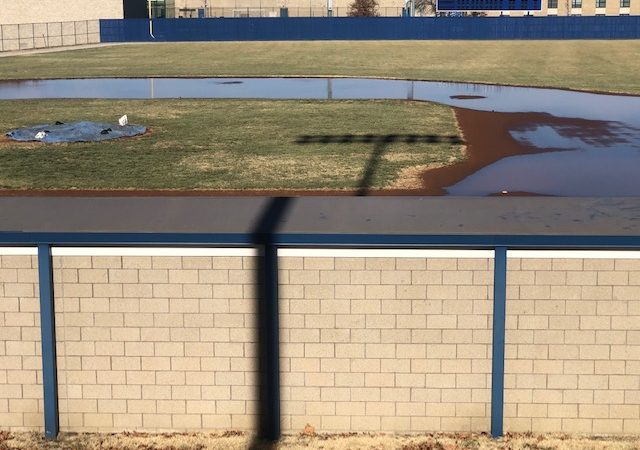Last-Minute Baseball Field Renovations

Can you believe spring sports start in just three months? The school pictured above finally received a donation for its baseball field renovation, and games start February 10 at the college level. Here’s how to execute a successful renovation with a short timeline in a situation like this.
First, pull out your renovation plans from August, contact a local professional sports field contractor, and start the process. Identify the main problems: rainouts from poor infield grade, lack of quality infield skin products, unsafe ball roll on the infield grass, and severe turf compaction.
Set a game plan around the winter weather for the next three months. Pump off the water standing in the skinned infield area to start the drying process with a trash pump. Order the infield material to match the current material before the weather changes, and cover a stockpile on site to keep it workable.
Be sure to flag and paint all irrigation heads and valve boxes. Verti-Quake the infield turfgrass, apron grass, and outfield turfgrass areas with one-inch tines to a depth of 10 inches. Topdress 100 to 150 tons of USGA sand to all turfgrass areas that have been Verti-Quake aerated to improve compaction relief by dragging sand into the channels while the skinned areas are drying. Lightly till to a one-inch depth the existing infield material and laser grade for proper drainage.
Transport new infield material from your on-site stockpile to the skinned area. Laser grade and roll the new material to your desired grade, removing air pockets and preparing an excellent playing surface for spring. Spread 40 bags of Heritage Red conditioner on the new surface and lightly nail drag into the top half-inch for proper moisture management. To achieve a beautiful green carpet for February, drill-seed an improved perennial ryegrass in two directions on the infield and apron areas at a rate of four pounds of pure live seed per thousand square feet per pass.
Fertilize with a balanced fertilizer based on soil sample recommendations. Cover the infield grass and apron with a winter growth blanket for proper seed germination and moisture management of the new infield skin. Likewise, cover the three outfielder areas with growth blankets for proper seed establishment for February play. Rebuild the pitching mound with a proper plateau and front grade. Install a new pitching rubber, base anchors, and bases. Lastly, rebuild the home plate area with mound clay for proper footing.
While waiting for dry days to work over the winter around Mother Nature’s obstacles, perform a site safety inspection of dugouts, fences, bleachers, and equipment. Work with your local Advanced Turf Solutions representative to improve the field when you remove the blanket in spring to keep ahead of scheduled wear.
Bill Norris
Sales Representative







